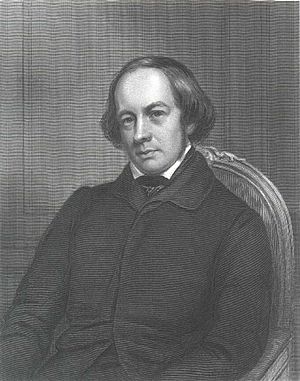Robert Kane (chemist) facts for kids
Quick facts for kids
Sir Robert Kane
|
|
|---|---|

Sir Robert Kane
|
|
| Born | 24 September 1809 |
| Died | 16 February 1890 (aged 80) |
| Nationality | Irish |
| Citizenship | British |
| Awards | Royal Medal (1841) |
| Scientific career | |
| Fields | Chemistry |
Sir Robert John Kane (born September 24, 1809 – died February 16, 1890) was an important Irish chemist and educator. He made big contributions to science and education in Ireland.
Contents
Robert Kane's Early Life and Studies
Robert Kane was born in Dublin, Ireland, in 1809. His father, John Kane, was also interested in chemistry. He had even studied chemistry in France. John Kane started a company that made sulphuric acid.
Young Robert learned a lot about chemistry at his father's factory. As a teenager, he went to lectures at the Royal Dublin Society. He published his first science paper in 1828. It was about finding chlorine in a mineral called manganese peroxide.
What is Kaneite?
In 1829, Robert Kane described a new natural compound. It was a mix of manganese and arsenic. Scientists named this compound Kaneite to honor him.
He later studied medicine at Trinity College, Dublin. He graduated in 1834 while also working at Meath Hospital. In 1831, he became a Professor of Chemistry. People called him the "boy professor" because he was so young. He also helped start the Dublin Journal of Medical Science.
Robert Kane's Academic Career
Robert Kane became a very respected scientist and educator. He wrote important books and held many important positions.
His Work in Chemistry
In 1832, Robert Kane was chosen to join the Royal Irish Academy. This happened because of his book, Elements of Practical Pharmacy. He studied different types of acids. He also showed that hydrogen had a positive electrical charge. He suggested that a chemical group called the ethyl group existed.
In 1836, he traveled to Germany to study organic chemistry. He learned from a famous chemist named Justus von Liebig. In 1843, he won the Cunningham Medal for his work on ammonia compounds.
Important Books and Reports
From 1841 to 1844, Kane published a three-volume book called Elements of Chemistry. He also wrote a detailed report about Ireland's industrial resources. This report included the first study of how much power the River Shannon could create. This power was later used to build the Ardnacrusha power plant in the 1920s.
Helping During the Great Famine
Robert Kane also became a government adviser. He gave advice on science and industry. He was part of several groups that looked into the Great Famine of Ireland. This was a terrible time when many people in Ireland faced starvation. His work in politics and administration meant he did less chemistry after 1844.
Robert Kane's Educational Leadership
Because of his work on Irish industry, Kane became the director of the Museum of Irish Industry in Dublin in 1845. This museum showed off Ireland's industrial achievements.
Also in 1845, he became the first President of Queen's College, Cork. This college is now called University College Cork. He didn't spend all his time in Cork because he had other work in Dublin. Today, a science building at University College Cork is named after him.
Later Roles and Honors
Robert Kane was knighted in 1846, which means he received the title "Sir." In 1873, he became the National Commissioner for Education. He was elected president of the Royal Irish Academy in 1877 and held that role until 1882. In 1880, he became the first leader of the new Royal University of Ireland.
Robert Kane's Family Life
Robert Kane married Katherine Sophia Baily in 1838. They had seven children who survived. His oldest son, Robert Romney Kane, became a lawyer. His second son, Henry Coey Kane, became an admiral in the Royal Navy.

